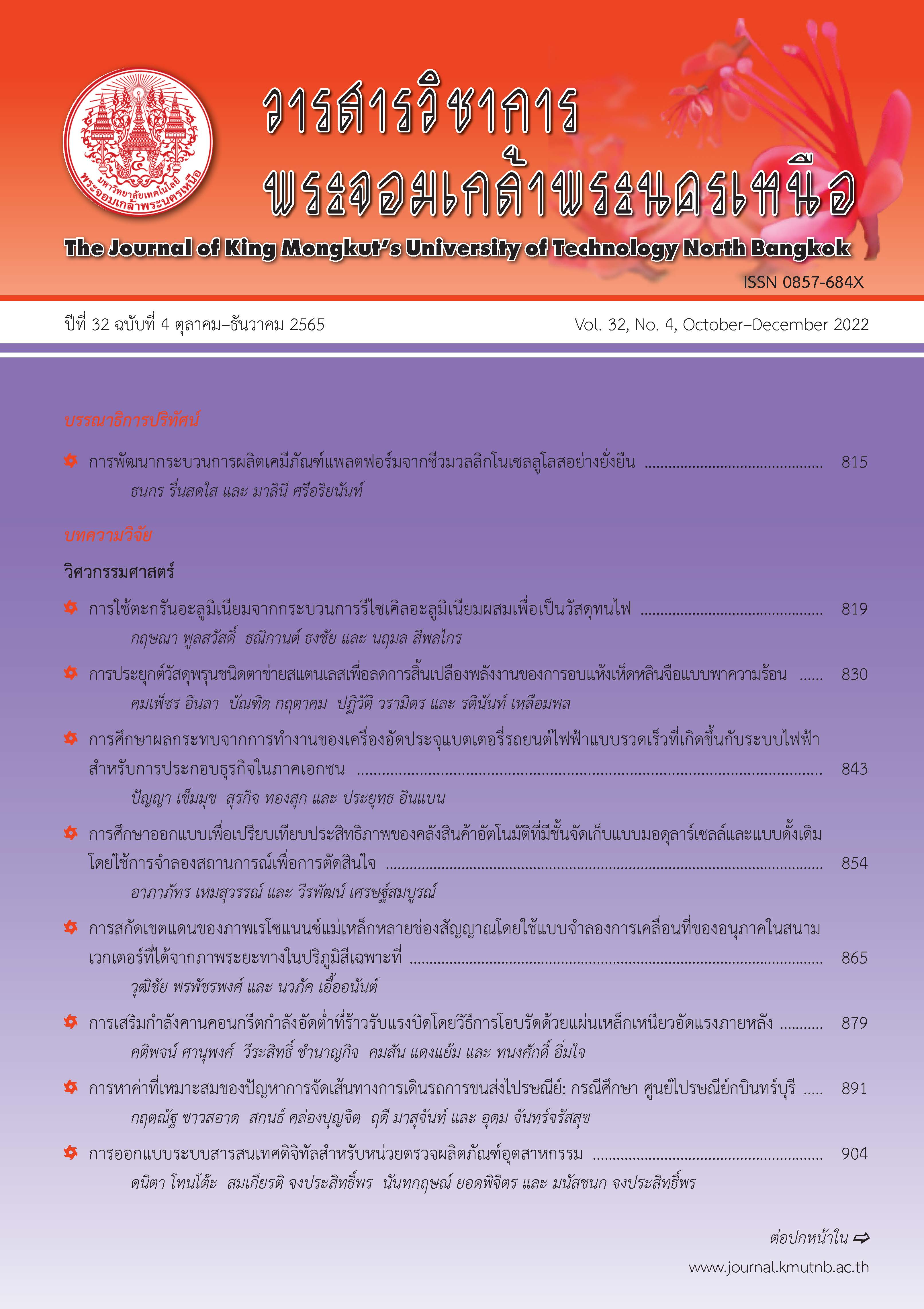กรณีศึกษาการเพิ่มประสิทธิภาพของกระบวนการบรรจุเนื้อปลาทูน่าแช่แข็ง
Main Article Content
บทคัดย่อ
ประสิทธิภาพการบรรจุเนื้อปลาทูน่าแช่แข็งขนาดบรรจุ 6 กิโลกรัม/ถุง ของบริษัทกรณีศึกษามีค่าต่ำกว่าค่าคาดหวังที่บริษัทกำหนด คือ มีค่า 51 ถุง/คน/ชั่วโมง เทียบกับ 60 ถุง/คน/ชั่วโมง ตามลำดับ เมื่อพิจารณาโดยอาศัยเครื่องมือทางการจัดการต่างๆ พบว่า สาเหตุที่ทำให้ประสิทธิภาพการบรรจุต่ำมีอยู่ 3 สาเหตุหลัก คือ จำนวนพนักงานไม่สอดคล้องกับแผนการผลิต ความชำนาญในการบรรจุของพนักงานแต่ละคนแตกต่างกัน และการเกิดคอขวดในขั้นตอนการชั่งปรับน้ำหนักที่ท้ายสายพานการผลิต ผลการศึกษา พบว่า บริษัทกรณีศึกษาสามารถลดจำนวนพนักงานบรรจุลงได้ 1 คน โดยไม่ส่งผลกระทบต่อน้ำหนักบรรจุ เมื่อกำหนดเวลามาตรฐาน (Standard Time) ที่ใช้ในการบรรจุเป็น 46.5 วินาที/ถุง ตามเวลาของพนักงานที่มีความชำนาญ และมีการฝึกอบรมพนักงานสามารถลดความสูญเสียได้จากเดิม 19.75% เป็น 12.75% (ลดลง 35.44%) ผลการทดลองยังพบว่า คอขวดที่ท้ายสายพานเกิดจากช่วงน้ำหนักของเครื่องชั่งไม่มีความเหมาะสม ภายหลังจากการปรับปรุงโดยการกำหนดจำนวนพนักงานที่เหมาะสม กำหนดเวลามาตรฐานในการบรรจุและฝึกอบรมพนักงาน และปรับช่วงน้ำหนักของเครื่องชั่งบนสายพาน พบว่า ประสิทธิภาพการบรรจุมีค่าเป็น 55, 59 และ 60 ถุง/คน/ชั่วโมง ตามลำดับ ซึ่งตรงตามประสิทธิภาพเป้าหมายและสามารถลดต้นทุนการผลิตได้ 648,000 บาท/วัน
Article Details

อนุญาตภายใต้เงื่อนไข Creative Commons Attribution-NonCommercial-NoDerivatives 4.0 International License.
บทความที่ลงตีพิมพ์เป็นข้อคิดเห็นของผู้เขียนเท่านั้น
ผู้เขียนจะต้องเป็นผู้รับผิดชอบต่อผลทางกฎหมายใดๆ ที่อาจเกิดขึ้นจากบทความนั้น
เอกสารอ้างอิง
Thai Tuna Industry Association. (2020, August). List of Exporters for Tuna Products Top 10 Country of the World in 2017–2019. [Online]. Available: https://www.thaituna.org/home/ annual-report.php
Thai Tuna Industry Association. (2020, August). Thai Exports of Tuna Products to the World by Countries in 2017–2019. [Online]. Available: https://www. thaituna.org/home/annualreport. php
Thai Tuna Industry Association. (2020, August). Thai Imports of Frozen Whole Round Tuna from the World by Countries in 2017–2019. [Online]. Available: https://www.thaituna.org/ home/ annual-report.php
Thai Tuna Industry Association (2020, August). Thai Imports of Frozen Raw Tuna by Species from the World in 2017–2019. [Online]. Available: https://www.thaituna.org /home/ annual-report.php
T. Khupulsup, “Productivity improvement in coconut shell product at the improvement of products made from coconut shells,” Industrial Technology Lampang Rajabhat University Journal, vol. 5, no. 1, pp. 49–57, 2012 (in Thai).
K. Poonikom, “Efficiency improvement in manufacturing process by improvement technique case study: Drinking water Bai- Pai-Keaw,” in Proceedings of the IE Network Conference, Department of Industrial Engineering, Faculty of Engineering, Chiang Mai University. Chiang Mai, Thailand, 2017, pp. 150–155 (in Thai).
C. Srila-or, K. Lumpungen, J. Kladrok, K. Mookdasanit, J. Jeera-on, and J. Junhom, “Research study to improve process safety through training by using the Why - Why Analysis principle and ECRS principles. Case study: Yakult (Thailand) Co., Ltd. Phra Nakhon Si Ayutthaya,” Journal of Administration and Management, vol. 10, no. 1, pp. 14–23, 2020 (in Thai).
T. Thongboonta, “Increasing work efficiency with negative reinforcement,” Journal of Humanities and Social Science, Rajapruk University, vol. 5, no. 3, pp. 14–27, 2020 (in Thai).
S. Eadmusik, T. Onwimon, T. Khiawlek, W. Rodsakan, and T. Saetan, “Over packing weight reduction of frozen imitation crab stick: A case study of Lucky Union Foods Company Limited,” The Journal of King Mongkut's University of Technology North Bangkok, vol. 32, no. 3, pp. 782–790, 2022 (in Thai).

